
Section 2. Water-related situation in the Aral Sea basin
2.1. Water in the Amu Darya and Syr Darya River Basins
Water Resources
In 2022, the total annual flow in the basins of the Amu Darya and the Syr Darya was 108.43 km3 or 92% of average long-term annual flow.
Amu Darya Basin
The annual flow in the basin (Amu Darya and Zerafshan rivers) was 68.7 km3, including 54.4 km3 at Kerki site of the Amu Darya River (upstream of diversion to the Garagumdarya Canal). The water content of the Amu Darya was estimated at 96% of the norm in the first quarter, 88% in the growing season, and 76% in October-December.
In total, 12.82 km3 of water were accumulated in Nurek and Tuyamuyun reservoirs by January 2022.
Syr Darya Basin
The annual flow in the basin, including the Naryn, Karadarya, Chirchik and small rivers, equaled 39.73 km3, of which 23.06 km3 was the total inflow into three reservoirs, such as Toktogul, Andizhan, and Charvak.
By January 2022, the total accumulation by basin’s reservoirs was 17.01 km3, including 11.58 km3 in the key reservoirs (Toktogul, Andizhan, and Charvak) located in the flow formation zone.
Operation of Reservoir Hydrosystems
The annual inflow into the Nurek reservoir was 20.87 km3, including 16.4 km3 or 79% of annual inflow in the growing season. Water releases from the reservoir equaled 20.86 km3/year, of which 13.03 km3 of water were discharged during the growing season.
Because of low flow in the Panj River , the annual inflow into the Tuyamuyun reservoir was 18.14 km3 only or by 5.14 km3 lower than the forecast. During the growing season the inflow was 12.82 km3. Annual water releases from the reservoir equaled 17.26 km3 or 80% of the value planned by the BWO Amu Darya. Accordingly, the discharge of water from the reservoir made up 12.97 km3 or 79% in the growing season.
The annual inflow into the Toktogul reservoir located on the Naryn River was 13.27 km3, including 10.43 km3 (79% of annual inflow) during the growing season. Annual water releases from the reservoir amounted to 12.31 km3, including 4.68 km3 (38%) during the growing season. The Toktogul reservoir was filled by 0.96 km3 and its storage reached 11.06 km3 by the end of the year.
Water Allocation and Water Shortage
Water distribution in the Amu Darya and Syr Darya basins (allocation of water withdrawal quotas) is done by the ICWC in the hydrological year dimension (October-September). The analysis of water distribution in the calendar year dimension (January-December) is shown below.
Amu Darya Basin
In 2022, with the limit of water withdrawal from the Amu Darya Basin set at 55.23 km3, 44.26 km3 were diverted in fact (31.38 km3 during the growing season). Thus, 80% of the annual water limit was used, including 79% - in the growing season. Water was allocated between the riparian states as follows:
• Tajikistan – with the water limit of 9.83 km3, the actual water withdrawal was 8.99 km3;
• Turkmenistan - with the water limit of 21.83 km3, the actual water withdrawal was 18.51 km3;
• Uzbekistan – with the water limit of 23.57 km3, the actual water withdrawal was 16.76 km3.
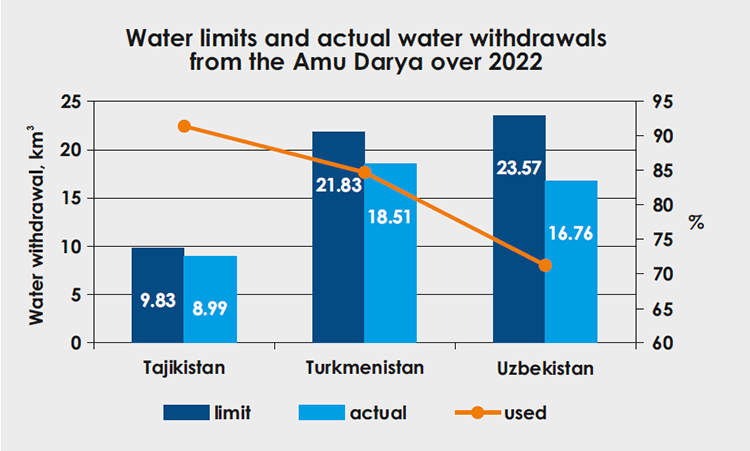
It was estimated in the growing season that water shortage in the river reach from the Nurek hydropower plant to the Tuyamuyun reservoir (Darganata site) reached 5% for Tajikistan, 7% for Turkmenistan, and 17% for Uzbekistan. Turkmenistan and Uzbekistan received 36% and 41%, respectively, less water than required in the reach from Darganata site to Samanbay site. Growing water shortage along the river during the growing season is explained by its unequal distribution over the territory.
Syr Darya Basin
The total water withdrawal in the Syr Darya Basin (up to entry point to the Shardara reservoir) amounted to 13.83 km3, including 10.17 km3 during the growing season or 86% of the established limit of water withdrawal into canals. No water was discharged from the Syr Darya into Arnasay.
86% of the water allocation plan set by the BWO Syr Darya was fulfilled. The water shortage in the reach from the Toktogul reservoir to the Chardara reservoir was estimated at 8% for Tajikistan, 36% for Kyrgyzstan, and 22% and 12% for Kazakhstan and Uzbekistan, respectively. Higher water shortage in Kyrgyzstan is because of its water needs exceeding the allocated water limit.
Inflow into the Aral Sea Region
According to the Kazakhstan’s Committee for Water Resources, in 2022, inflow into the Northern Aral Sea from the Syr Darya was 0.82 km3. No water was discharged from the Northern Sea into the Large Aral Sea (Eastern body).
Based on SIC's estimates, the South Aral region is supposed to get 8 km3 from the Amu Darya River in average and wet years and 3.5 km3 in dry years. In fact, 2.06 km3 of water was delivered to the South Aral region in 2022.
Meeting the Demands
The table below shows how water demands were met for the CA countries during the growing season.

Source: SIC ICWC using the data from BWO Amu Darya and the BWO Syr Darya
2.2. Large Aral Sea and the Amu Darya Delta
This Section was prepared using the data of the BWO Amu Darya, the Aral Sea Region Delta Authority, and the Uzbek Hydrometeorological Service (UzHydromet) and based on RS-monitoring of Eastern and Western bodies of the Large Aral Sea (LAS) and the lake systems in the Amu Darya River delta using Landsat 8 OLI images (http://cawater-info.net/aral/data/monitoring_amu.htm). Since 2022, NDVI with the refined threshold values has being used for satellite imagery analysis to identify three surface categories: 1) open water surface, 2) wetland, 3) dryland. Until 2022, the total area of a water body has been determined as the sum of open water surface and wetland areas. However, the problem of detecting wetlands, i.e. the possibility to distinguish them from dry, degraded land, remained open. The information for 2021 and 2022 on http://cawater-info.net/aral/data/index.htm was updated using the improved methodology. Thus, some differences can be found when making comparison with the data in the past years.
2.2.1. Water Supply to the Amu Darya Delta and the Large Aral Sea
Water Supply to the Amu Darya Delta
According to BWO Amu Darya, in 2022, 2,055 Mm3 of water (flow from the river and water discharged from canals and collecting drains) reached the Amu Darya delta. This is by 451 Mm3 more than in 2021.
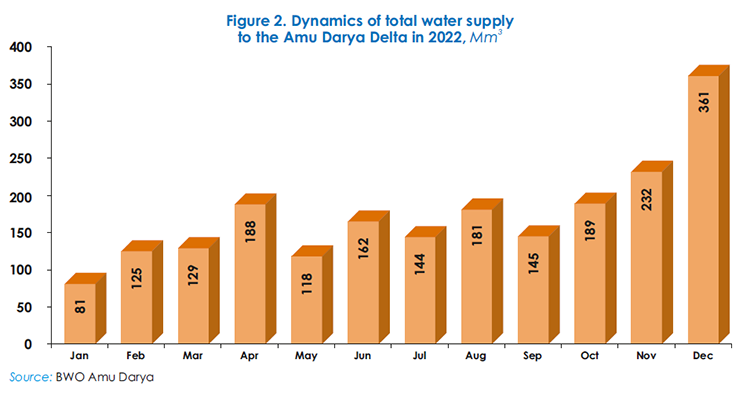
Flow from the Main South-Karakalpak collecting drain to the exposed bed of the Large Aral Sea
Bypassing the Amu Darya Delta, 503.5 Mm3 of collector-drainage water flowed towards the exposed bed of the Large Aral Sea from the Main South-Karakalpak (Right-bank) collecting drain (Table 1). This is by 36.15 Mm3 more than in 2021 (467.35 Mm3).

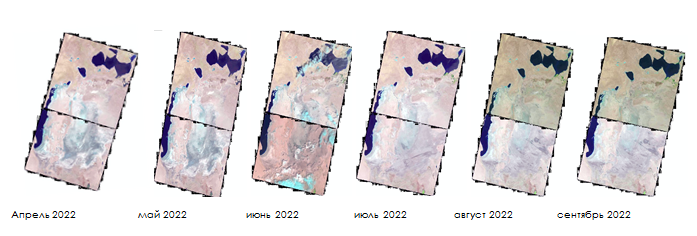
Total inflow into the Large Aral Sea
In 2022, the total inflow into the Large Aral Sea (LAS) decreased from 650.35 Mm3 (2021) to 503.5 Mm3. The LAS got water from the Main South Karakalpak collecting drain (SKCD) only. No water was discharged from the Amu Darya River Delta and the Northern Aral Sea (NAS) (Table 2).
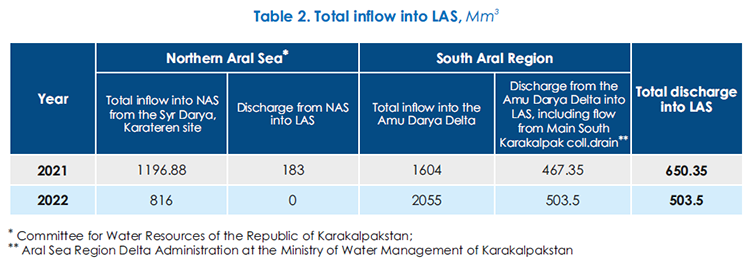
2.2.2. Open Water Surface and Wetlands in Eastern and Western Parts of the Large Aral Sea
As monitoring and GIS data for 2022 shows, (1) the water surface area in Western part of LAS slightly decreased from 220.0 to 211.8 thousand ha, while the wetland area shrank dramatically (from 284.6 to 9.8 thousand ha), and the dryland area extended 6 fold (from 56.6 to 339.6 thousand ha); (2) the water surface area in Eastern part of LAS decreased from 1.6 to 0.046 thousand ha, dropping to 0.025 thousand ha in July and increasing to 0.145 thousand ha in August. Wetlands shrank a lot from 1,292.38 to 6.1 thousand ha (Table 3).
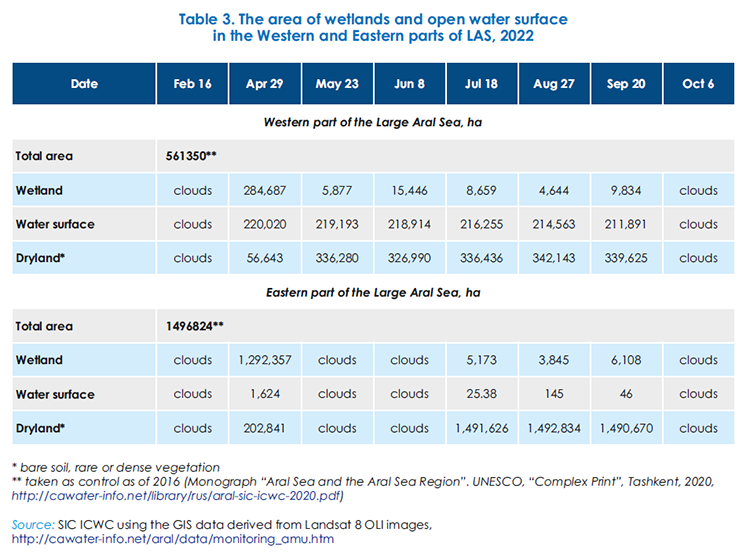
2.2.3. Lake Systems in the Amu Darya Delta
Lake systems in the Amu Darya delta are comprised of small local water bodies in the South Aral region. Overall, as compared to 2021, the hydrological situation deteriorated in 2022. The actual water area of the lake systems accounted for 5 (February) to 1.5% (October) of the design area (353,644 ha). In the period from February to October, the open water surface area of the lake systems shrank from 23.6 to 6.2 thousand ha, while the area of wetlands, from 101.2 to 45.1 ha (Table 4). The supply of 2,055 Mm3 of water to the Amu Darya delta did not create favorable environment for fishery and ecosystem in such lakes as Sudoche, Rybache, Muynak and Djiltirbas.
The decreased inflow of water from collecting drains into local lakes in the South Aral region was caused by reduced supply of water to the delta of the Amu Darya (Figure 2) during the growing season (Table 5).


Conclusion
Despite the increased supply of water to the Amu Darya delta and discharge from SKCD as compared to 2021, inflow into LAS decreased in 2022. The areas of water surface and wetlands in Eastern and Western parts of LAS also shrank. Local lakes in the South Aral Region continue suffering from unstable water supply.